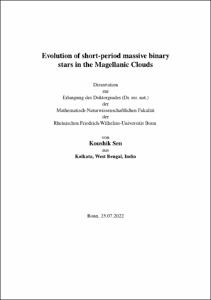Sen, Koushik: Evolution of short-period massive binary stars in the Magellanic Clouds. - Bonn, 2022. - Dissertation, Rheinische Friedrich-Wilhelms-Universität Bonn.
Online-Ausgabe in bonndoc: https://nbn-resolving.org/urn:nbn:de:hbz:5-68385
Online-Ausgabe in bonndoc: https://nbn-resolving.org/urn:nbn:de:hbz:5-68385
@phdthesis{handle:20.500.11811/10363,
urn: https://nbn-resolving.org/urn:nbn:de:hbz:5-68385,
author = {{Koushik Sen}},
title = {Evolution of short-period massive binary stars in the Magellanic Clouds},
school = {Rheinische Friedrich-Wilhelms-Universität Bonn},
year = 2022,
month = oct,
note = {Massive stars tend to form in close binaries that will interact during their lifetime. Up to one-third of them are so close that they undergo mass transfer during hydrogen burning and yield most of the observable post-interaction binaries. As rapid binary evolution codes cannot provide accurate predictions for these systems, we study them using large grids of detailed binary evolution models that include internal differential rotation and magnetic angular momentum transport, time-dependent tidal coupling, and a self-consistently derived mass and angular momentum transfer prescription. Through follow-up population synthesis, we derive the observable properties of massive semi-detached binaries, Wolf-Rayet/helium star binaries, black hole/neutron star binaries, pre-supernova stars and their companions, for constant star formation as well as for coeval star cluster populations.
We find that our tide and spin dependant mass transfer efficiency model can reproduce most properties of the observed massive Algol population, while a purely conservative or non-conservative model does not. We also show that Bondi-Hoyle wind accretion during the BH+O star phase is expected to lead to observable X-ray emission only in exceptionally favourable cases such as high angular momentum accretion efficiency onto the black hole, very low wind speed from the O star companion, and high spin of the black hole. This creates a strong bias towards observing high-mass black hole X-ray binaries with rapidly spinning BHs, as is seen in observations (Cyg X-1, LMC X-1 and M33 X-7). Our results provide important constraints for the evolution of massive binaries towards detectable gravitational wave sources.},
url = {https://hdl.handle.net/20.500.11811/10363}
}
urn: https://nbn-resolving.org/urn:nbn:de:hbz:5-68385,
author = {{Koushik Sen}},
title = {Evolution of short-period massive binary stars in the Magellanic Clouds},
school = {Rheinische Friedrich-Wilhelms-Universität Bonn},
year = 2022,
month = oct,
note = {Massive stars tend to form in close binaries that will interact during their lifetime. Up to one-third of them are so close that they undergo mass transfer during hydrogen burning and yield most of the observable post-interaction binaries. As rapid binary evolution codes cannot provide accurate predictions for these systems, we study them using large grids of detailed binary evolution models that include internal differential rotation and magnetic angular momentum transport, time-dependent tidal coupling, and a self-consistently derived mass and angular momentum transfer prescription. Through follow-up population synthesis, we derive the observable properties of massive semi-detached binaries, Wolf-Rayet/helium star binaries, black hole/neutron star binaries, pre-supernova stars and their companions, for constant star formation as well as for coeval star cluster populations.
We find that our tide and spin dependant mass transfer efficiency model can reproduce most properties of the observed massive Algol population, while a purely conservative or non-conservative model does not. We also show that Bondi-Hoyle wind accretion during the BH+O star phase is expected to lead to observable X-ray emission only in exceptionally favourable cases such as high angular momentum accretion efficiency onto the black hole, very low wind speed from the O star companion, and high spin of the black hole. This creates a strong bias towards observing high-mass black hole X-ray binaries with rapidly spinning BHs, as is seen in observations (Cyg X-1, LMC X-1 and M33 X-7). Our results provide important constraints for the evolution of massive binaries towards detectable gravitational wave sources.},
url = {https://hdl.handle.net/20.500.11811/10363}
}






